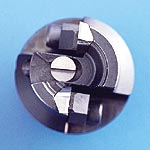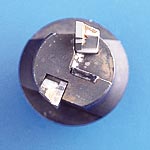Consolidated Diesel Co. had a problem. The Whitakers, N.C., company was unhappy with the results of a trepanning operation that it regularly performs on cast iron cylinder heads.
CDC’s chief engineer, Richard Scalise, said that the problem was tool life—or the lack thereof. “It was catastrophic,” he said.
CDC was getting fewer than 500 parts out the brazed-tipped tools it was using before having to invest an hour or more to change them. On a shuttle station, with seven tools in each station, 500 pieces come around pretty quickly. CDC was replacing tools 248 times a year, which boosted the cost per piece to $5.84.
CDC needed a solution and found it by having McQuade Industries Inc. redesign the trepanning tool. The Clinton Township, Mich., toolmaker specializes in designing and building indexable tools. CDC had worked with McQuade before and the results had been positive. Scalise decided to give the company a call.


Shown at left is the redesigned trepanning tool. The toolmaker replaced the old tool’s (right) brazed tips with indexable inserts. As a result, Consolidated Diesel saw the number of parts produced between tool changes rise from 500 to 4,000.
Tim Lewerenze, McQuade’s tool design engineer, wanted to provide a tool that would be more cost-effective and easier to setup. Sounds simple, doesn’t it? That’s the point, he said. “All through school they’d tell us to use the KISS method: Keep It Simple, Stupid.”
The first step in redesigning the tool was to replace the brazed tip with a significantly thicker indexable insert. Lewerenze explained that the original trepanning tool’s thin carbide tip was prone to breaking in the cut. McQuade came up with an arrangement whereby two solid-carbide, V-bottom inserts mount in the holder.
“We had enough room on the insert so we could give them two edges to cut with,” explained Lewerenze.
Each insert slides into its pocket and locks in place when tightened. No touching off is needed before running the tool because the insert is designed to load exactly the same way every time.
There’s also a double-lead edge on the front of the insert, so even in the event of a crash, there’s still a locating wall that allows the insert to be flipped. “Unless it’s an outrageous crash that breaks the whole pocket, you still have a chance to index and get life out of the insert,” said Lewerenze.
After CDC began using the new trepanning tool, the number of parts machined per tool jumped from 500 to 4,000 (2,000 per cutting edge). Tool-change times dropped from one hour to 15 minutes. The number of annual tool changes fell from 248 to 62.
“The initial [indexable tool] body is where you’re going to take a hit, but then as soon as you start replacing a hundred of these inserts you really start to save,” he said.
The brazed tool cost $104 and provided only one cutting edge, so when it was dull or chipped CDC tossed it. The initial cost of the redesigned tool was higher—about $1,000—but McQuade Vice President Dinos Karagounis said that it soon paid for itself.
Each insert costs about $32.50, and with two cutting edges per insert, the cost per edge is $16.25.
The cost per piece has dropped from $5.84 to just under 23 cents since CDC adopted the new tool. As a result, the company could save $693,000 annually.
“It’s hard to digest, but it’s a fact,” said Scalise.
He also said that the first redesigned tool worked well, so no tweaking of the design was needed. This allowed CDC to continue running parts without interruption.
“You don’t usually hit a home run off the first pitch,” said Scalise.
Related Glossary Terms
- indexable insert
indexable insert
Replaceable tool that clamps into a tool body, drill, mill or other cutter body designed to accommodate inserts. Most inserts are made of cemented carbide. Often they are coated with a hard material. Other insert materials are ceramic, cermet, polycrystalline cubic boron nitride and polycrystalline diamond. The insert is used until dull, then indexed, or turned, to expose a fresh cutting edge. When the entire insert is dull, it is usually discarded. Some inserts can be resharpened.
- pitch
pitch
1. On a saw blade, the number of teeth per inch. 2. In threading, the number of threads per inch.
- sawing machine ( saw)
sawing machine ( saw)
Machine designed to use a serrated-tooth blade to cut metal or other material. Comes in a wide variety of styles but takes one of four basic forms: hacksaw (a simple, rugged machine that uses a reciprocating motion to part metal or other material); cold or circular saw (powers a circular blade that cuts structural materials); bandsaw (runs an endless band; the two basic types are cutoff and contour band machines, which cut intricate contours and shapes); and abrasive cutoff saw (similar in appearance to the cold saw, but uses an abrasive disc that rotates at high speeds rather than a blade with serrated teeth).
- trepanning
trepanning
Drilling deep holes that are too large to be drilled by high-pressure coolant drills or gundrills. Trepanning generates a solid core and normally requires a big, powerful machine. Shallow trepanning operations can be performed on modified engine or turret lathes or on boring machines. See boring; drilling; spade drilling.
